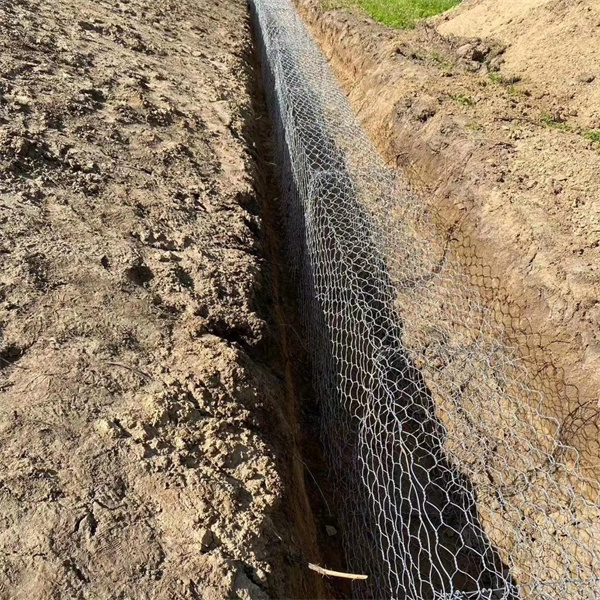Dec . 01, 2024 09:32 Back to list
Design and Implementation of Gabion Drop Structures in China
Understanding Gabion Drop Structures in China
Gabion drop structures represent an innovative approach in the realm of hydraulic engineering, particularly in China, where rapid infrastructure development often intersects with environmental concerns. These robust structures, made from wire mesh filled with rocks or other materials, serve various purposes in managing water flow and mitigating erosion. As China's landscape is characterized by numerous rivers and streams, the strategic use of gabion drop structures can significantly enhance the stability and safety of waterways.
What are Gabion Drop Structures?
Gabion drop structures are specifically designed hydraulic installations that provide a controlled descent of water, reducing the energy and velocity of flowing water to prevent downstream erosion. Typically, these structures consist of a series of gabion baskets stacked to create a tiered drop, allowing water to flow smoothly from one level to another. The rocks within the baskets serve to dissipate energy, minimize turbulence, and create a stable base for the structure itself.
Benefits of Using Gabion Drop Structures
1. Erosion Control One of the primary advantages of gabion drop structures is their effectiveness in controlling erosion. By reducing water velocity at critical points within a river or creek, these structures prevent the destabilization of banks and surrounding land. In a country like China, where deforestation and agriculture can exacerbate erosion, gabion structures offer a natural solution that integrates well with the environment.
2. Cost-Effectiveness Constructing traditional concrete drop structures can be both expensive and labor-intensive. Gabion structures, on the other hand, are often less costly and quicker to install. The materials used—typically local stones—are often readily available, which also helps in reducing transportation costs.
3. Environmental Benefits Gabion structures are eco-friendly, promoting the growth of vegetation and wildlife in and around the waterbody. The gaps in the mesh allow for sediment deposition and plant growth, establishing a more stable biological habitat compared to concrete structures, which can disrupt local ecosystems.
4. Aesthetic Integration Beyond functionality, gabion drop structures can be designed to blend into the natural landscape. Their rugged appearance can complement scenic riverbanks, making them an attractive alternative to some more industrialized structures.
china gabion drop structure

Applications in China
In China, gabion drop structures have found applications in various engineering projects, particularly in regions vulnerable to flooding and soil erosion. The unique geography of China, which includes mountainous areas and plains, means that effective water management strategies are crucial.
For instance, in rapidly urbanizing areas along rivers, these structures can effectively manage stormwater flow and reduce the risk of urban flooding. Additionally, in rural areas where agricultural activities are prevalent, gabion drop structures can protect farmland from water runoff, thereby preserving soil quality and agricultural productivity.
Challenges and Considerations
While gabion drop structures offer numerous benefits, there are challenges that engineers and planners must consider. The longevity of the wire mesh is paramount; rust and deterioration can compromise the structure’s integrity over time. Regular maintenance and inspections are necessary to ensure that the baskets remain intact and functional.
Furthermore, the design of these structures must consider the specific hydrology of the area. Understanding water flow patterns, potential debris loading, and sediment movement is essential for optimizing the performance of gabions in different environmental conditions.
Conclusion
Gabion drop structures represent an effective, sustainable solution for managing water flow and controlling erosion in China. Their versatility, cost-effectiveness, and minimal environmental impact make them an appealing choice for engineers and urban planners alike. As China continues to grow and face challenges related to water management, the intelligent application of gabion technology will play a crucial role in ensuring the safety and sustainability of its waterways. This innovative approach not only highlights China's commitment to modern engineering but also its growing awareness of environmental stewardship.
-
Visualizing Gabion 3D Integration in Urban Landscapes with Rendering
NewsJul.23,2025
-
The Design and Sustainability of Gabion Wire Mesh Panels
NewsJul.23,2025
-
The Acoustic Performance of Gabion Sound Barriers in Urban Environments
NewsJul.23,2025
-
Mastering the Installation of Galvanized Gabion Structures
NewsJul.23,2025
-
Gabion Boxes: Pioneering Sustainable Infrastructure Across the Globe
NewsJul.23,2025
-
Custom PVC Coated Gabion Boxes for Aesthetic Excellence
NewsJul.23,2025
-
Installation Tips for Gabion Wire Baskets in Erosion Control Projects
NewsJul.21,2025






